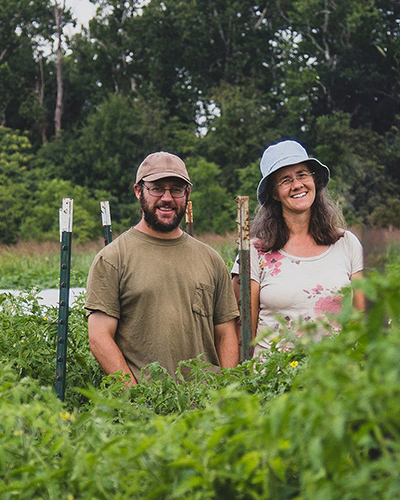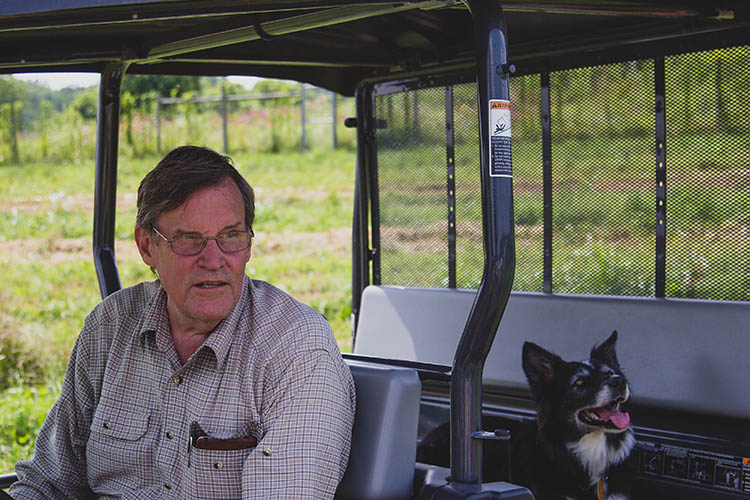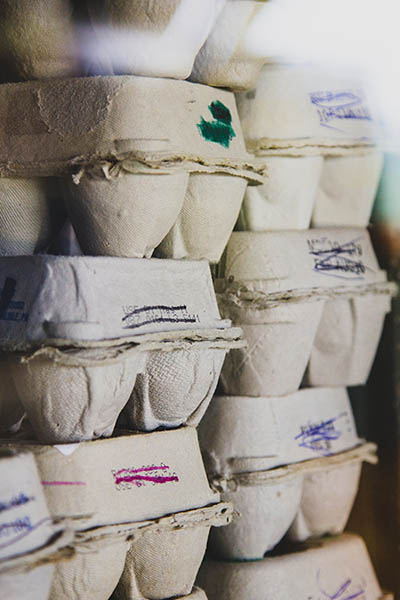A long-term lease that creates ownership
Eric Plaksin and Rachel Bynum are standing near a row of peak summer tomatoes in a field that, after 15 years of farming, feels very much like their own, when the landowner pulls up in his golf cart with his dog Hannah perched in the backseat.

“They aren’t disparaging me are they?” Cliff Miller asks with a grin.
He knows enough about the farming couple — with which he has a 40-yearlong lease agreement — to answer his own question. But, in his early 70s and as sharp as ever, he doesn’t miss an opportunity to jibe them.
Miller goes on to offer up his perspective on the lease, and why more people should consider partnerships like the one he’s forged here.
“A 40-year lease throws us both on the same trail. We both want the best thing to happen,” he said. “More people should do that, but they’ve gotta trust each other.”
Bynum and Plaksin were in their early 30s when they first signed the lease to farm 27 of the 850 acres that Miller’s family owns in Rappahannock County. In the 15 years since, Waterpenny Farm has flourished as an example of what ecological growers can accomplish with the support of a long-term lease.
The farmers will be at least 70 by the time the contract is up, and their two children will be almost 40.
“We feel ownership for this land,” Bynum said. “We care about it and we know it. We feel like we’re going to be here for our careers.”
When it comes to long-term leases, the kind that support growers who are benefiting the landscape and the community, “that ownership feeling is kind of what you’re going for,” Bynum adds.
But the deal that reinforces their thriving business here was several years in the making.
“We feel ownership for this land. We care about it and we know it. We feel like we’re going to be here for our careers.”
The early years
After meeting Bynum at college in Minnesota, Plaksin went on to Wheatland Vegetable Farms in Loudoun County, where he cut his farming teeth during four years in the fields. Bynum worked in environmental education at the Chesapeake Bay Foundation’s Clagett Farm while also doing seasonal work at the vegetable farm.
But they were ready to start their own operation. “We drew a big circle around DC” and started looking for land to buy. But, a few trips with a realtor showed that most of what they could afford didn’t include a place to live, let alone the infrastructure and community they’d need to make a farming business work.

“As we looked at what we could have afforded to buy, it was like a bad house or no house in the middle of a field,” Bynum said of their search for land within a drive of DC’s markets.
Around the same time, Miller had begun his own search for an organic vegetable grower. He had rented land to conventional farmers in the past but, after enrolling several hundred acres in conservation programs, had a change of heart about the best use for the land his family had owned for generations.
“When the previous managers left, there was a lot of bad stuff like Johnson grass growing in here,” Miller said during a drive across his land in the fall. “My solution was to get an organic vegetable farm to come in and pull the Johnson grass out by hand, rather than put a bunch of Roundup on the soil.”
Miller reached out to Wheatland for farmer recommendations, and “Eric and Rachel were as good a fit as there is.”
The pair didn’t jump on the opportunity at first, because it came up too close to the spring planting season.

“We wanted to plant cover crops. Nobody’s going to successfully bust sod in the spring and have a good farm going,” said Bynum, who now grows produce on just 8 of the acres they manage.
When he asked again later in the year, they were ready. In 1999, the farmers moved into a small white house that had years ago housed migrant orchard workers, and they began planting.
The farmers paid their rent in sweat equity those first two years, chipping away at projects on the old house and the landscape. They paid to rent farming equipment from Miller as needed.
“It allowed us to try it out and see if it was going to work for us,” Plaksin said.
Waterpenny Farm — named for an ecologically sensitive bug seen in streams on the property — had in that first year landed a coveted spot at the Takoma Park Farmers Market in DC. The market is their biggest source of income to this day, along with the Arlington Farmers Market and a 100-member CSA program.
After deciding the land was the right fit, the couple expressed interest in a long-term lease, something that would basically allow them to stay on the land “until we die.” Miller wanted that, too, but he also wanted the next generation of his family to have choices.
“My history of short-term leases with good farmers indicated that that doesn’t work for me anyway,” he said. “So if you can get a 40-year lease, that’s like owning it.”
Plaksin and Bynum agreed that such a long-term lease would be the best fit for them as well, but it still took about three years to craft the 50-page agreement. Bynum said that was partly because there were few, if any, examples of such arrangements that they could use as templates.
The freedom of leasing
Also complicating the lease was language surrounding the home that the couple built and owns — on land they do not. The lease states that, should Plaksin and Bynum decide to leave with 90 days’ notice, Miller Properties has to buy back for the appraised value the two houses and barn that the couple owns.
The arrangement helps the farmers build equity without owning the land or having to worry about their investments on the property being lost.
“We went into leasing because we couldn’t afford to buy, but we think there are some advantages to being part of something bigger,” Plaksin said.
Waterpenny’s lease includes a land use agreement that neither party use chemicals that would harm the environment. Since Miller owns all the property surrounding their farm — far more acreage than the couple could afford to buy as a buffer — they don’t have to worry about how their neighbors’ actions might affect an ecological farm.
Conversely, Plaksin said, “It’s in our interest to take care of the soil, not just to try to use it up and go somewhere else.”
“We went into leasing because we couldn’t afford to buy, but we think there are some advantages to being part of something bigger.”
Not having to pay a mortgage on the land and having good markets meant that Plaksin and Bynum could invest in their farming business early on — and turn a profit in their first year. That profit has grown a little bit each of the years since, allowing the farmers to invest in retirement funds and college funds for their children.
They also invest in other farmers.
Waterpenny hires about six interns a year and, besides paying them good wages, offers up an educational opportunity that has inspired many of them to branch out on their own. (The interns almost always ask how they landed that enviable 40-year lease.)
Ben Stowe started his own Little Hat Creek Farm last year after interning at Waterpenny and said the experience showed him he could make money, pay workers well and “have a good life” as a farmer.
“I used to feel like we were choosing to make less money than we could make doing other things,” Plaksin said, noting that many people stick with farming for the lifestyle. “But we’re doing well enough that I don’t know what else I would do to make better money.”
This story is part of “Finding a Place to Grow“, a publication produced by The Piedmont Environmental Council. The stories were written by Whitney Pipkin, a freelance journalist from Alexandria, VA who covers food, farms, and the environment. Her work appears in the Washington Post, Virginia Living and the Chesapeake Bay Journal, among others, and she writes at thinkabouteat.com. Photos were taken by Jami McDowell.
The publication was made possible by a grant from The Beirne Carter Foundation.
